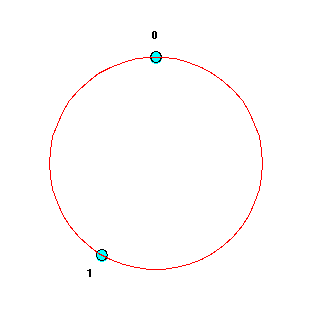- Putting these two points together:
a faithful geometric picture of the set of pitch classes is
a circle of length 1. The easiest way to place the points on the
circle is to choose as basepoint the pitch class correcponding to
frequencies which are exact powers of 2, e.g. 256 (approximately
middle C), 512, 1024, etc. Then
each other pitch class gets displayed along the circle at a distance from the
basepoint equal to the fractional part of its
logarithm to the base 2. As the frequency approaches twice
the base frequency, the fractional part of its
logarithm to the base 2 gets closer to 1, and we get back
to the basepoint, as required.
Here is a circle of length 1 with a basepoint marked "0" and the class corresponding to its third harmonic marked "1". The distance between two points along the circle is the fractional part of the logarithm of the ratio of their frequencies; in this case it is the fractional part of log23, or frac(log23) = 0.584962501.... (The points are drawn here with pitch increasing clockwise).


